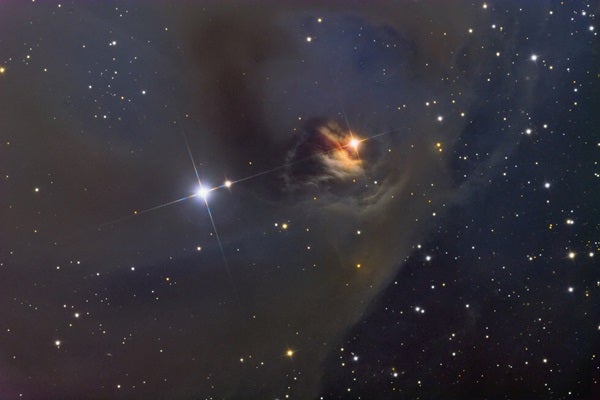We’ll begin with one of the least targeted of Hind’s discoveries, NGC 4125. Hind happened upon this 10th-magnitude “tolerably bright” lens of light with a “strong nuclear condensation” in January 1850, although he was unaware of its true nature. What he had discovered is a peculiar massive elliptical galaxy in which evolved stars produced in a merger-triggered burst of star formation are pumping large amounts of gas and dust into the galaxy’s interstellar medium. You’ll find this 6′ by 3′ hidden treasure about 5° southeast of Kappa (κ) Draconis.
Changing lights
Next up is the tricky NGC 1555 — a nebula that varies in brightness, shape, and size along with its luminary: the 1-million-year-young variable star T Tauri, which fluctuates between magnitude 8.5 and 13.5 with no known period. Popularly known as Hind’s Variable Nebula, NGC 1555 was the first of its type to vary in size, shape, and brightness.
Using moderate-sized apertures, I (and many others) had long searched for the nebula without success in past decades. In 2016, however, I began reading reports from observers who’d spotted the nebula through telescopes as small as 6 inches. Finally, in July 2019, I spied its shy glow through an 8-inch reflector, with T Tauri glowing around magnitude 10.5 and the nebula appearing as a little flirtatious skirt of diaphanous light less than 1′ west of the star. So, unless the winds of change choose to blow, perhaps you’ll have luck as well.
On December 15, 1855, Hind encountered a previously uncharted 9th-magnitude star in Gemini that he thought was a nova. Now designated U Geminorum, this dwarf nova — a cataclysmic binary system where a white dwarf is accreting matter, usually from a red giant star — is the prototype of its class and the first to be discovered.
Usually, U Gem rests around magnitude 14.5, but every 100 days or so, it flares — many times up to 8th magnitude — in less than a day, before fading over the course of days or weeks. Catching an outburst may send a tingle up your spine. Curiously, Hind’s contemporary, Norman Pogson, noted that the star takes on a “pale bluish white tint when near maximum; never ruddy.” When he observed the star at its first reappearance after its discovery, he noted a “curious scintillation or twinkling” about the third day after maximum, “which could not arise from atmospheric disturbances, as neighbouring smaller stars were not similarly affected.”
Crimson dynamo
Hind’s discovery most observed by amateur astronomers is R Leporis. When Hind discovered this Mira-type variable star in 1845, he described it as “resembling a blood drop on the background of the sky.” Since then, it has become known as Hind’s Crimson Star — a burning ember reminiscent of a red-hot coal that fluctuates in brightness from a maximum magnitude of 5.5 to a minimum of 12 over a period of roughly 427 days.
The luminary appears so red because its highly evolved atmosphere is surrounded by a sooty shell of carbon and carbon compounds. That material makes R Leporis one of the reddest stars visible.
Queen’s rock
This month we also have a Hind solar system discovery on the rise in the east: main-belt asteroid 12 Victoria, which Hind found in September 1850. Named in honor of Queen Victoria, it was the first asteroid to be named after a living person. The roughly 75-mile-wide (120 kilometers) rock orbits the Sun with a period of 3.56 years.
It shines around 12th magnitude at the beginning of January 2020 and one magnitude brighter toward month’s end. You’ll find it in the constellation Sextans: on January 1 at right ascension 10h17m51s and declination –1°06’39”; on the 15th at R.A. 10h13m05s and Dec. –1°32’44”; and on the 31st at R.A. 10h01m42s and Dec. –1°19’02”.
As always, send your comments to sjomeara31@gmail.com.










